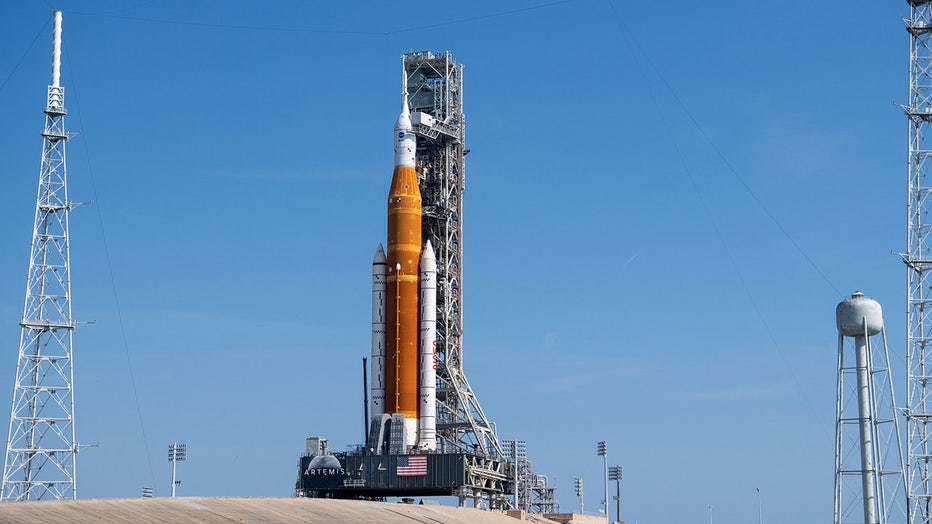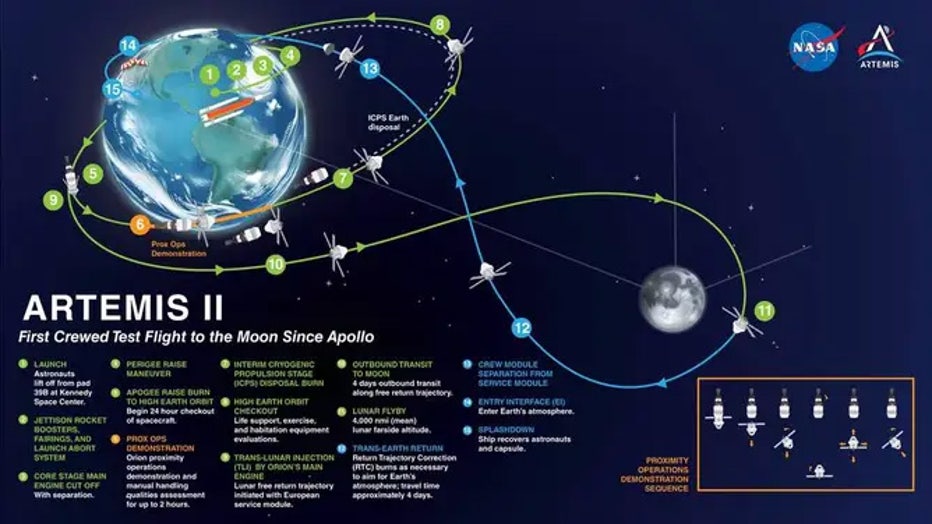NASA's moon rocket 'go' for Artemis I launch after final review

NASA’s Space Launch System (SLS) rocket with the Orion spacecraft aboard is seen atop a mobile launcher at Launch Pad 39B, Wednesday, Aug. 17, 2022, after being rolled out to the launch pad at NASA’s Kennedy Space Center in Florida. (NASA/Joel Kowsky
CAPE CANAVERAL, Fla. - NASA managers have given the Space Launch System moon rocket the green light to move ahead with launching for the first time from Kennedy Space Center in Florida.
Artemis program management met Monday at KSC for the flight readiness review to go over every element of the SLS and uncrewed Orion spacecraft mission known as Artemis I. After a full day, no one objected to moving forward with the first launch of the massive 322-foot-tall rocket.
HOW TO WATCH THE ARTEMIS 1 LAUNCH
Artemis I Launch Director Charlie Blackwell-Thompson said the launch "call to stations" happens Saturday. SLS could launch within a 2-hour window that opens at 8:33 a.m. ET on Monday, Aug. 29.
"We are go for launch, which is absolutely outstanding. This day has been a long time coming," NASA Associate Administrator Robert Cabana said.
Cabana, a former astronaut and the longtime NASA Kennedy Space Center director, said he was inspired by watching Apollo 13 launch in 1970.
"I'm a product of the Apollo generation, and look what it did for us," he said. "I cannot wait to see what comes from the Artemis generation because I think it's going to inspire even more than Apollo did."

NASA’s Space Launch System (SLS) rocket with the Orion spacecraft aboard is seen atop a mobile launcher at Launch Pad 39B, Thursday, Aug. 18, 2022, after being rolled out to the launch pad at NASA’s Kennedy Space Center in Florida. (NASA/Joel Kowsky)
NASA leaders stressed that Artemis I is the first full test of SLS and the Orion from launch to landing, and risk is associated with it. The launch will mark the first time since 1967 that NASA will conduct a test flight of a moon rocket.
The Orion capsule was designed for a 21-day mission. However, NASA plans to extend that to a 42-day spaceflight.
"We are pushing the vehicle to its limits, really stressing it to get ready for crew. It is incredibly risky," NASA Associate Administrator for Exploration Systems Development Jim Free said. "We talked about our mitigation steps for those risks, and we've mitigated the risk as far as we can. And now it's our time to get to launch so that we get that data that we need to put crew on it."
After launching from Kennedy Space Center launchpad 39B with 8.8 million pounds of thrust, the SLS will send the Orion spacecraft on a trajectory to orbit the moon.
WHAT IS NASA'S ARTEMIS 1 MISSION GOING TO DO?
When the spacecraft orbits the moon, it will have traveled about 40,000 miles beyond the far side of the moon, which is more distant than any human-rated spacecraft that has journeyed before. This is known as the distance retrograde orbit or DRO.

Artemis II: Astronauts on their first flight aboard NASA’s Orion spacecraft will travel farther into the solar system than humanity has ever traveled before. (NASA)
Orion will spend about two weeks in orbit before beginning the journey back to Earth.
The last part of the test flight includes one of the main objectives of Artemis I, which is testing the Orion heat shield as the spacecraft re-enters Earth's atmosphere at 25,000 mph.
Artemis I culminates with the Orion splashing down in the Pacific Ocean on Oct. 10. However, NASA managers said the mission could be shorter depending on how things go.
A successful mission will set the stage for Artemis II, an astronaut mission to orbit the moon. By 2025, NASA plans to land four astronauts on the lunar South Pole, becoming the first moonwalkers since Apollo 17 in 1972.

